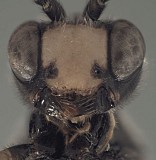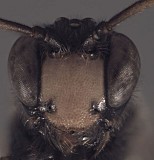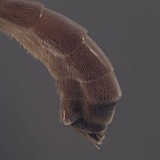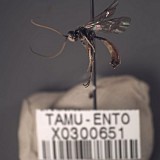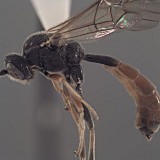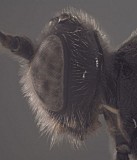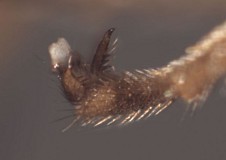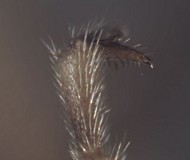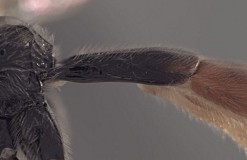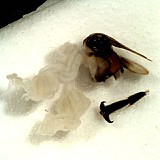Clypeus (Fig. 3) with surface more or less uniformly setose and punctate to granular-punctate; ventral margin varying from evenly and distinctly convex to weakly convex and nearly truncate to nearly dentate or angled forward medially and appearing slightly emarginate when the head is tilted backwards as in Fig. 4; margin blunt; epistomal sulcus usually absent, broadly and shallowly impressed, especially in males, in a few species; clypeus in profile flat to weakly protruding. Face flat to weakly bulging in profile; setose, densely punctate to granular-punctate; inner eye margins more or less parallel. Ocelli small, diameter of lateral ocellus much less than distance from ocellus to eye. Malar space distinct, varying from a little less than half basal width of mandible to nearly equal basal width of mandible; malar sulcus absent. Mandible (Fig. 4) broad, gradually narrowing from base to apex; weakly to strongly curved; dorsal tooth usually equal to or slightly larger than ventral tooth, rarely with ventral tooth larger; basal, transverse impression well-developed; ventral margin distinctly carinate. Maxillary palp a little shorter than height of head; female antenna equal to or slightly shorter than body; equal in length to or longer than body in male. Hypostomal carina meeting occipital carina distinctly above base of mandible; occipital carina complete. Epomia well-developed in some species, obscured by surrounding sculpture in others and either absent or difficult to discern. Epicnemial carina reaching anterior margin of mesopleuron. Notaulus variable: commonly absent, broad and shallow in some species, sometimes marked by more distinct punctation extending posteriorly past level of tegula and converging to a very broad, very shallow, median depression, distinctly impressed anteriorly in a few species. Groove between propodeum and metapleuron broadly u-shaped, readily visible in lateral view in most species, less so in a few species, where it appears more v-shaped; broad, u-shaped groove mid-dorsally between propodeum and metanotum present and usually readily visible in lateral view; pleural carina well-developed, complete; propodeal carinae variably developed, completely carinate, with well-delineated areola, in some species; median longitudinal carinae always well developed, lateral longitudinal carina sometimes poorly developed to absent anteriorly, posterior transverse carina usually complete but sometimes absent or indistinct laterally, anterior transverse carina often absent laterally and/or medially, with areola and median basal area confluent; petiolar area usually with median longitudinal carina. Apical margin of mid tibia expanded into a distinct tooth similar to that of fore leg; apical comb on posterior side of hind tibia absent; posterior hind tibial spur long, 0.3-0.5 times length of hind basitarsus; tarsal claws variously pectinate, densely and completely so on all legs in type species and the closely related
R. clapini, more sparsely so and often basally situated in many other species, as in Figs. 6 and 7. Fore wing areolet present, though often with large bulla on one side; stigma varying from relatively narrow as in the type species, with Rs+2r arising near basal 0.3 of stigma to broader and wedge or triangular in shape, with Rs+2r arising near middle or less commonly near basal 0.3-0.4. Hind wing with first abscissa of CU1 longer than 1cu-a, often very much longer. T1 (Fig. 8) longer and more slender in the type species and a few others, but more commonly shorter and relatively stout, gradually expanding from base to apex; straight in profile; dorsal carinae usually sharp and well developed at least to level of spiracle and often more posteriorly but rarely extending full length of T1; basal depression at dorsal tendon attachment deep, broad; dorsal-lateral carina usually complete between spiracle and apex of T1; glymma large, deep, basally situated. S1 extending to level of spiracle or nearly so in the type species and a few others, extending only about 0.3 times length of T1 in many species. T2 thyridium absent, at least one species with a well-developed carina between anterior margin of T2 and spiracle; laterotergites of T2 and T3 separated by creases from median tergite. Ovipositor (Figs 9, 10) straight; ovipositor and sheath usually directed dorsally at rest; ovipositor relatively shorter than in
Pion, somewhat gradually becoming needle-like apically from distinctly swollen base (Fig. 10); without dorsal, subapical notch.
The above description is greatly modified from Townes (1970) and is based on several species in the Texas A&M University collection. A detailed description is also presented by Gauld (1997).

